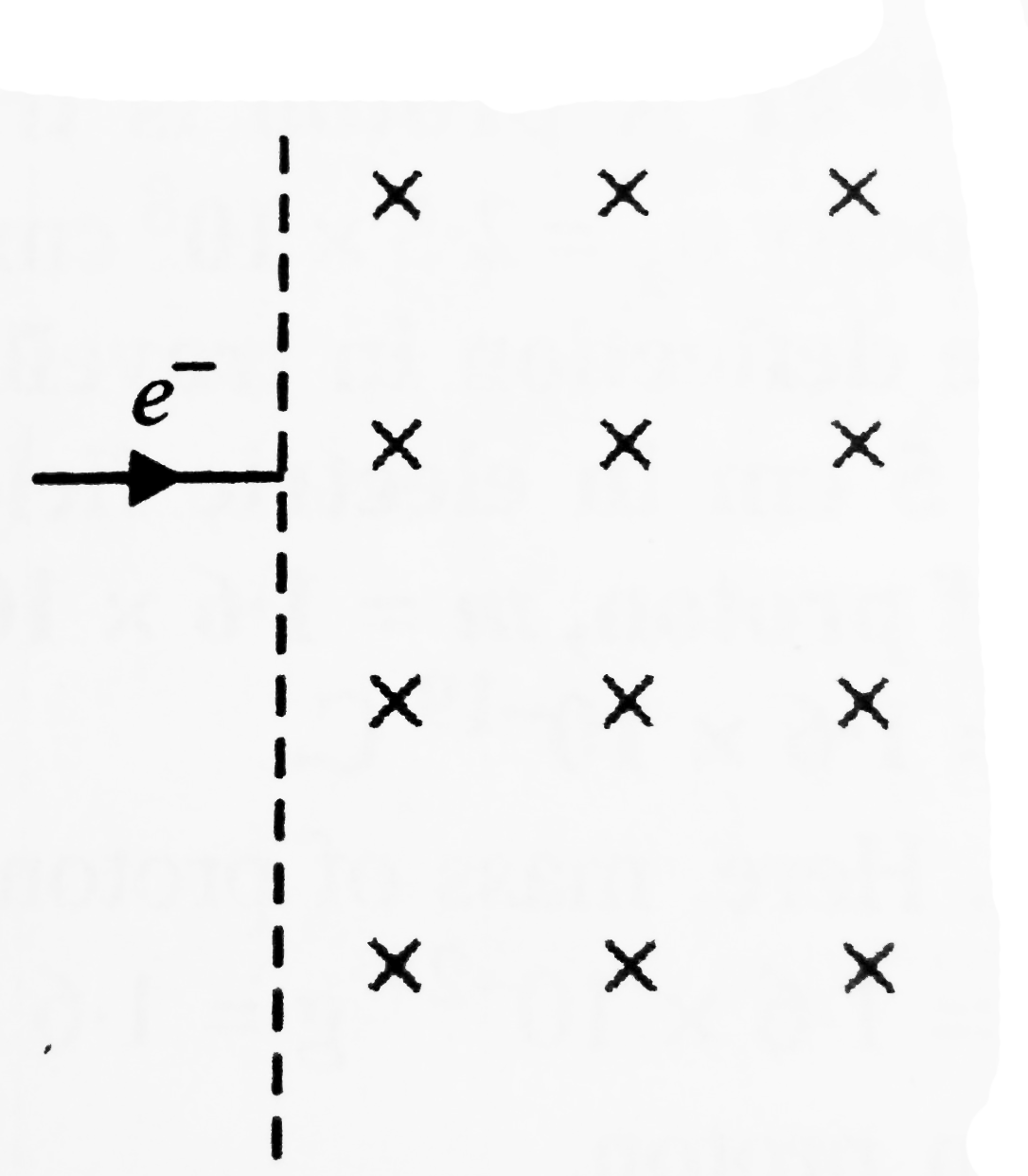An electron entering field normally with a velocity 4×107ms−1 travels a distance of 0.10 m in an electric field of intensity 3200Vm−1. What is the deviation from its path?
1.76mm
17.6mm
176mm
0.176mm
The correct Answer is:A
To solve the problem of finding the deviation of an electron entering an electric field, we can follow these steps:
Step 1: Identify the Given Values
- Velocity of the electron, v=4×107m/s
- Distance traveled in the electric field, x=0.10m
- Electric field intensity, E=3200V/m
- Charge of the electron, e=1.6×10−19C
- Mass of the electron, m=9.1×10−31kg
Step 2: Calculate the Force on the Electron
The force F acting on the electron in the electric field is given by:
F=Q⋅E=−e⋅E
Since the electron has a negative charge, the force will act in the opposite direction to the electric field. The magnitude of the force is:
F=1.6×10−19C×3200V/m=5.12×10−16N
Step 3: Calculate the Acceleration of the Electron
Using Newton's second law, the acceleration a of the electron can be calculated as:
a=Fm=5.12×10−16N9.1×10−31kg≈5.62×1014m/s2
Step 4: Calculate the Time of Travel in the Electric Field
The time t taken to travel the distance x can be calculated using the formula:
t=xv=0.10m4×107m/s=2.5×10−9s
Step 5: Calculate the Vertical Displacement (Deviation)
The vertical displacement y due to the acceleration during the time t can be calculated using the formula for uniformly accelerated motion:
y=12at2
Substituting the values:
y=12⋅5.62×1014m/s2⋅(2.5×10−9s)2
Calculating t2:
t2=(2.5×10−9)2=6.25×10−18s2
Now substituting back:
y=12⋅5.62×1014⋅6.25×10−18≈1.76×10−3m=1.76mm
Final Answer
The deviation from its path is approximately 1.76mm.
---
- Velocity of the electron, v=4×107m/s
- Distance traveled in the electric field, x=0.10m
- Electric field intensity, E=3200V/m
- Charge of the electron, e=1.6×10−19C
- Mass of the electron, m=9.1×10−31kg
The force F acting on the electron in the electric field is given by:
F=Q⋅E=−e⋅E
Since the electron has a negative charge, the force will act in the opposite direction to the electric field. The magnitude of the force is:
F=1.6×10−19C×3200V/m=5.12×10−16N
Using Newton's second law, the acceleration a of the electron can be calculated as:
a=Fm=5.12×10−16N9.1×10−31kg≈5.62×1014m/s2
The time t taken to travel the distance x can be calculated using the formula:
t=xv=0.10m4×107m/s=2.5×10−9s
The vertical displacement y due to the acceleration during the time t can be calculated using the formula for uniformly accelerated motion:
y=12at2
Substituting the values:
y=12⋅5.62×1014m/s2⋅(2.5×10−9s)2
Calculating t2:
t2=(2.5×10−9)2=6.25×10−18s2
Now substituting back:
y=12⋅5.62×1014⋅6.25×10−18≈1.76×10−3m=1.76mm
The deviation from its path is approximately 1.76mm.
Topper's Solved these Questions
Similar Questions
A stream of electrons moving with a velocity of 3×107ms−1 is deflected by 2 mm in traversing a distance of 0.1 m in a uniform electric field of strength 18Vm−1 in Fig. 1.42. An electron enters the field symmetrically between the plates with a speed υ0. The length of each plate is l. Find the angle of deviation of the bath of the electron as it comes out of the field.
View SolutionAn electron is moving with a velocity of 107ms−1 on a circular path of radius 0.57cm in a magnetic field of 10−2Wbm−2. Find the value of e/m for the electron.
View Solution
Knowledge Check
A proton enters a magnetic field of 1.5 T with a velocity of 2×107ms−1 at an angle of 30∘ with the field. The force on the proton will be
A2.4×10−12NB0.24×10−12NC24×10−12ND0.024×10−12NAn electron enters in a magnetic held of induction 2 m T with velocity of 1.8×107 m/s . The radius of circular path is
A5.1 cmB5.1 mmC5 kmD2.1 cm
An electron moving with a velocity 5×106ms−1ˆi in the uniform electric field of 5×107Vm−1ˆj Find the magnitude and direction of a minimum uniform magnetic field in tesla that will cause the electron to move undeviated along its original path .
View SolutionAn electron is emittied with a veloctiy of 5×106ms−1 . It is accelerated by an electric field in the direction of initial velocity at 3×1014ms−2 . If its final velocity is 7×106ms−1 calculation the distance coverd by the electron .
View SolutionA diople consisting of an electron and a proton separated by a distance of 4×10−10 m is situated in an electric field of intensity 3×105NC−1 at an angle of 30∘ with the field. Calculate the diople moment and the torque acting on it. Charge e on an electron =1⋅6×10−19C.
View SolutionAn electron moving with a speed of 2.5×10−7ms−1 enters a space between two horizontal metal plates which a uniform electric field of 1600Vm−1 is maintained. What will be its deflection from its straight line path on emerging out if the length of each plate is 10cm and the electron enters in a direction perpendiular to the electric field ?
View SolutionA stream of electrons moving with a velocity of 6×107ms−1 passes between two parallel plates. An electric field of 3000Vm−1 is applied between the plates. Calculate the strength of the magnetic field required to keep the electron undeflected.
View SolutionAn electron moving horizontally with a velocity of 4×104ms−1 enters a region of uniform magnetic field of 10−5T, acting vertically downwards as shown in figure. Draw its trajectory and find out the time it takes to come out of the region of magnetic field.

View Solution
